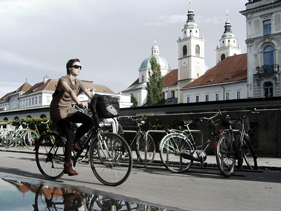Europe’s new green capital

Transforming urban life in the past decade and minimizing the city’s environmental impact. Photo by Rhobinn/Flickr.
Sustainable development and integrated planning mark Europe’s new green capital
Ljubljana recently won the 2016 European Green Capital Award based on its comprehensive approach to sustainable development, which has transformed urban life in the past decade while minimizing the city’s environmental impact.
Ljubljana, Slovenia has won the 2016 European Green Capital Award, given annually by the European Commission to cities that set an example of sustainable urban development best practices.
With an ambitious sustainability plan and that has led to significant improvements in the past decade, the capital of Slovenia joins cities such as Bristol, elected as the 2015 winner and Copenhagen, elected as the 2014 winner. The award considers the city’s urban and environmental management strategies and commitment to sustainability. Specifically, the European Commission takes into account indicators such as climate resilience, urban mobility, air quality, waste management, and water quality among other factors.
Ljubljana was chosen primarily because of its sustainability plan Vision 2025, which calls for an integrated approach to achieving ambitious sustainable development goals.
The plan includes an Environmental Protection Program, a Sustainable Mobility Plan, a Sustainable Energy Action Plan, and an Electromobility Strategy. Implementation of these and other measures in recent years has transformed life in the Slovenian capital. The Mobility Plan, adopted in 2012, aims to create equal use of the city’s public transport, cars, and non-motorized modes of transport by 2020. It has already helped increase the mode share of public transport to 27.7%. The city also altered vehicular traffic flow to prioritize pedestrians and cyclists, which, in combination with other measures such as transport fare card integration, has increased the speed and reliability of public transport.
Ljubljana has also emerged as a European leader in addressing climate change. Its climate goals are ambitious, as the city has proposed plans to reduce emissions by anywhere from 50% to 80% by 2050 from 2008 levels.
This goal follows the city’s commitment to transparency regarding environmental information. The World Summit Award, a United Nations initiative, selected Ljubljana’s Thermal Power Plant (TE-TOL) as one of the world’s five best practices in the area of environmental protection and health for its communication with residents about its emissions and effects on health and the environment.
In recent years, hundreds of projects have improved the environment and quality of life in Ljubljana. Below are just a few of the results already achieved:
- Two million trips have been made on the public bike program BicikeLJ since 2011. About 10% of the population regularly uses the system.
- About 75% of the area of the city is made up of green space. Between 2008 and 2012, the city created 40 hectares of new parks, and now has approximately 560 square meters of green space per inhabitant.
- The use of private transport fell from 47% to 19% in the city centre between 2003 and 2013. During the same period, the use of public transport rose from 20% to 27.7%, and the number of pedestrians increased from 33% to 53.3%.
- 3,500 waste containers have been replaced by 51 underground waste collectors.
- The city won the European Prize for Urban Public Space in 2012.
These are only a few of Ljubljana’s admirable efforts to improve urban mobility, the environment, and quality of life.
Valere Tjolle
This week special offer – whole library of current sustainable tourism reports and guides – 93% off HERE
 United Kingdom
United Kingdom United States
United States Asia Pacific
Asia Pacific












































Dozens fall ill in P&O Cruises ship outbreak
Turkish Airlines flight in emergency landing after pilot dies
Boy falls to death on cruise ship
Unexpected wave rocks cruise ship
Woman dies after going overboard in English Channel